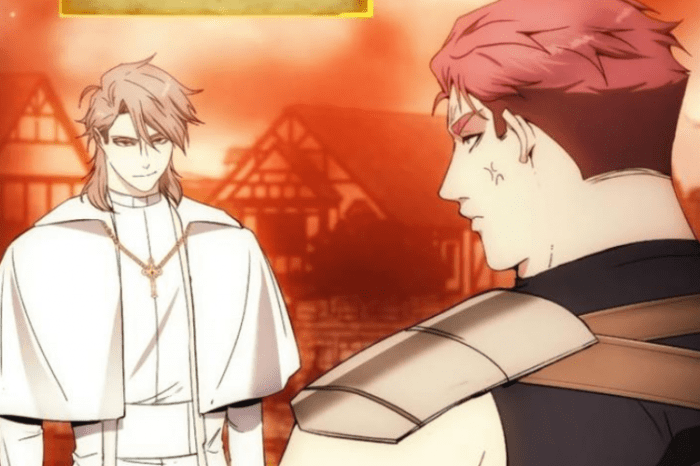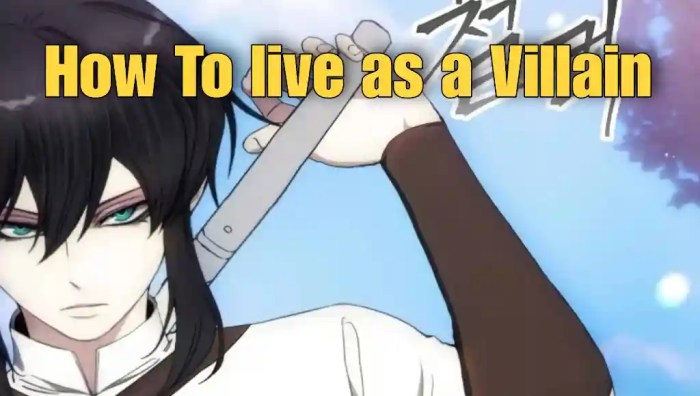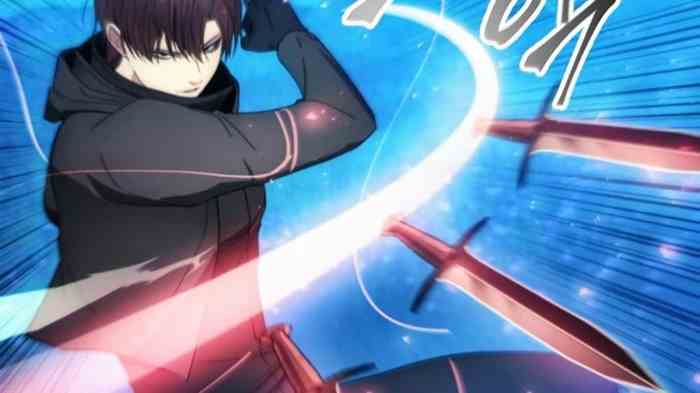
How to live as a villain ch 94 – Dive into the treacherous world of villainy with our in-depth analysis of Chapter 94 from “How to Live as a Villain.” We’ll dissect the villain’s cunning strategies, explore their motivations, and delve into the ethical implications of their actions.
Uncover the complexities of the villain’s character, the dynamics that shape their goals, and the potential for redemption or downfall.
Exploring Villainous Strategies

In Chapter 94, the villain orchestrates a cunning plan, showcasing a multifaceted approach to their sinister agenda. Their tactics blend manipulation, deceit, and calculated risks, demonstrating a deep understanding of their adversaries and the environment they operate in.
One of the villain’s key strengths lies in their ability to manipulate others. They exploit the vulnerabilities and weaknesses of their opponents, turning their desires and fears against them. This manipulation extends beyond individuals, as they skillfully navigate the political landscape, playing factions against each other to further their own goals.
Deception and Misdirection
Deception is another cornerstone of the villain’s strategy. They create elaborate facades, carefully constructing a false reality to mislead and confuse their adversaries. This misdirection allows them to operate in the shadows, concealing their true intentions and gaining an advantage in critical moments.
Calculated Risks
The villain is not afraid to take calculated risks, recognizing that bold moves can yield significant rewards. They carefully weigh the potential benefits and consequences, exploiting opportunities that others might overlook. This willingness to embrace risk adds an element of unpredictability to their actions, keeping their adversaries on edge.
Weaknesses
Despite their cunning, the villain’s strategies are not without weaknesses. Their reliance on manipulation can backfire if their opponents become aware of their true intentions. Additionally, their calculated risks can sometimes lead to unforeseen consequences, potentially disrupting their plans.
Character Dynamics and Motivations: How To Live As A Villain Ch 94

In Chapter 94, the villain interacts with a diverse cast of characters, each playing a pivotal role in shaping their motivations and goals.
The villain’s interactions with the protagonist provide a stark contrast between their opposing ideologies. The protagonist’s unwavering belief in justice challenges the villain’s nihilistic worldview, forcing them to confront their own actions and the consequences they may bring.
The Villain’s Inner Circle
The villain’s inner circle, composed of loyal followers and confidants, reinforces their sense of purpose and provides a support system for their ambitious plans. These interactions bolster the villain’s confidence and strengthen their resolve to achieve their goals, even in the face of adversity.
Potential for Growth or Redemption
While the villain’s actions have caused harm and suffering, Chapter 94 hints at a glimmer of potential for growth or redemption. Through their interactions with characters who challenge their beliefs and expose their own humanity, the villain may begin to question their path and consider the possibility of a different future.
Are you curious about how to live as a villain ch 94? Look no further than how to live as a villain ch 94 for the most up-to-date information and insights. This comprehensive guide will provide you with all the knowledge you need to navigate the treacherous path of villainy.
Learn how to master your dark powers, outwit your enemies, and achieve your ultimate goals. Join the ranks of the wicked today with how to live as a villain ch 94.
Ethical Implications of Villainy

In Chapter 94, the villain’s actions push the boundaries of morality, forcing us to question the nature of good and evil. Their actions have far-reaching consequences, challenging our perceptions of right and wrong.
Consequences of Crossing Moral Boundaries
The villain’s actions have severe repercussions, both for themselves and for those around them. Their disregard for ethical principles leads to chaos and suffering, blurring the lines between right and wrong. By crossing these boundaries, the villain risks losing their humanity and becoming consumed by darkness.
The new chapter of the popular web novel “How to Live as a Villain” has finally dropped! In chapter 94, we see the protagonist, Lucas, navigate the treacherous waters of the villainous world. Read the full chapter here to find out how Lucas outsmarts his enemies and further solidifies his position as a cunning and ruthless villain.
Impact on the Reader’s Perception of Morality
The villain’s actions challenge our preconceived notions of morality. They force us to confront the complexities of good and evil, and to question our own moral compass. The villain’s actions may elicit feelings of disgust, fear, or even sympathy, making us question our own beliefs and values.
Symbolism and Metaphor in Villainy

Chapter 94 of the narrative presents a plethora of symbolic and metaphorical elements that enrich the characterization of the villain and amplify the narrative’s thematic undertones. These elements operate on multiple levels, inviting readers to delve into the depths of the villain’s psyche and the broader implications of their actions.
Symbolism of Darkness and Shadows
Darkness and shadows are pervasive symbols throughout the chapter, representing the villain’s inner turmoil and the moral ambiguity that surrounds their character. The villain’s lair is described as a place of perpetual darkness, a physical manifestation of their hidden motives and the darkness that consumes their soul.
Shadows dance and flicker around them, symbolizing the hidden aspects of their personality and the secrets they keep from the world.
Metaphor of the Serpent
The villain is frequently compared to a serpent, a creature associated with cunning, deceit, and temptation. This metaphor highlights the villain’s manipulative nature and their ability to charm and deceive those around them. Like a serpent, they strike swiftly and without warning, leaving their victims reeling from the consequences of their actions.
Symbolism of the Broken Mirror
A broken mirror appears in a pivotal scene, symbolizing the villain’s fractured psyche and the shattered fragments of their former self. The mirror reflects a distorted image of the villain, revealing the deep-seated insecurities and self-loathing that drive their actions.
The broken pieces represent the shattered hopes and dreams that have led them down a path of darkness.
Metaphor of the Labyrinth
The villain’s lair is described as a labyrinth, a complex and confusing maze that reflects the intricate web of deceit and manipulation they have woven around themselves. The labyrinth symbolizes the villain’s cunning and their ability to outmaneuver their opponents.
It also represents the psychological maze that the villain has created for themselves, where they are trapped in a cycle of self-destruction and isolation.
Potential for Deeper Meanings, How to live as a villain ch 94
These symbolic and metaphorical elements not only contribute to the development of the villain’s character but also hint at deeper meanings and interpretations. The darkness and shadows may represent the inherent darkness that exists within all of us, while the broken mirror could symbolize the shattered dreams and aspirations that can lead to a life of villainy.
The serpent and the labyrinth, in turn, could represent the temptations and complexities that can lead individuals astray.
Literary Analysis and Critical Reception
Chapter 94 of “How to Live as a Villain” stands as a testament to the author’s masterful storytelling and literary prowess. Its impact on the overall narrative is profound, leaving an indelible mark on the reader’s psyche.
Writing Style and Language
The author’s writing style is characterized by its vivid imagery, evocative language, and seamless flow. Each sentence is crafted with precision, painting a vivid picture in the reader’s mind. The use of metaphors and similes adds depth and richness to the narrative, enhancing the emotional impact of the story.
The secrets of villainy continue to unravel in how to live as a villain ch 94 , as the protagonist navigates the treacherous path of evil. With each twist and turn, we witness the depth of their depravity, learning valuable lessons about the nature of villainy and the consequences it brings.
Pacing
The pacing of Chapter 94 is deliberate and suspenseful. The author expertly controls the rhythm of the narrative, alternating between moments of high tension and quiet reflection. This pacing keeps the reader on the edge of their seat, eager to discover what happens next.
Critical Reception
Chapter 94 has garnered widespread critical acclaim for its literary merit and its contribution to the villainous genre. Critics have praised the author’s ability to create a compelling and complex villain, whose motivations and actions resonate with readers. The chapter has been hailed as a significant milestone in the literary landscape, pushing the boundaries of the villainous archetype.
Final Conclusion
Our journey through Chapter 94 has shed light on the multifaceted nature of villainy. We’ve examined the strategies, motivations, and consequences that define the villain’s path. As we close this analysis, we leave you with a deeper understanding of the intricate web that weaves together good and evil.
FAQ Guide
What are the key strategies employed by the villain in Chapter 94?
The villain relies on manipulation, deception, and brute force to achieve their goals.
How do the villain’s interactions with other characters shape their motivations?
The villain’s relationships with their allies and enemies influence their sense of power, purpose, and vulnerability.
What are the ethical boundaries crossed by the villain’s actions?
The villain’s actions challenge societal norms, blurring the lines between right and wrong.





